Radish
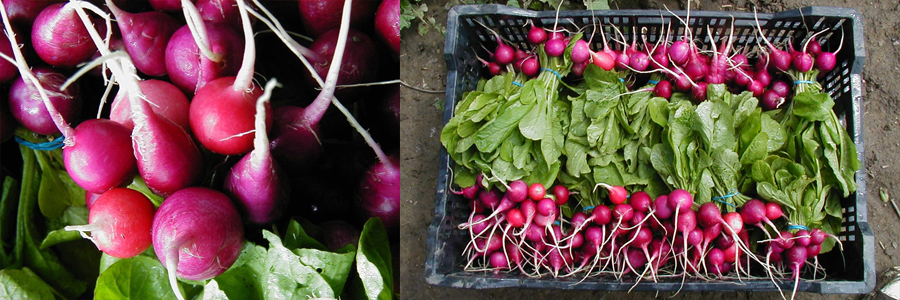
The Latin word, “radix,” meaning “root,” is the “root word,” so to speak, for our modern word “radish,” as well as the related mathematical term “radical,” the political adjective “radical,” and the technical botanical noun “radical.” Today we’ll stay grounded in the kitchen and discuss the roots we eat.
I remember a woman who stopped by my farmers’ market stand in San Jose many years ago. She looked at a large pile of bunched radishes that I had heaped up. “Those look awfully small for beets,” she said, “but they’re a pretty purple color.”
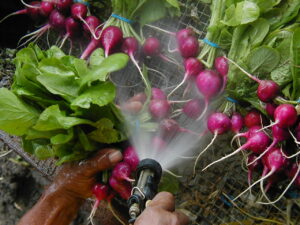 “They’re not beets, I replied. “They’re ‘Plum Purple’ radishes. It’s a Japanese variety. The flavor is the same as a red radish, but Plum Purple radishes stay nice and crunchy and mild, even when they get quite large. And the Japanese appreciate the greens as a leafy vegetable for cooking up or putting in soups, so you can see the leaves are long, tender, and smooth.”
“They’re not beets, I replied. “They’re ‘Plum Purple’ radishes. It’s a Japanese variety. The flavor is the same as a red radish, but Plum Purple radishes stay nice and crunchy and mild, even when they get quite large. And the Japanese appreciate the greens as a leafy vegetable for cooking up or putting in soups, so you can see the leaves are long, tender, and smooth.”
“Radishes are supposed to be red,” she said. “A purple radish? I could never try that.” And she scurried off.
“Wow,” I thought. “She doesn’t like to be challenged to try anything new in the kitchen.” Every culture has certain foods that they esteem more than others. Here in the United States we’ve made a popular fetish out of our tomatoes; seed catalogues show off an amazing spectrum of heirloom tomatoes in all their myriad colors, we prize our beefsteak tomatoes for how big they get, our gardens showcase many varieties of cherry toms, we have our favorite tomatoes for sauces, and salads, but when it comes to radishes many Americans are not yet so sophisticated.
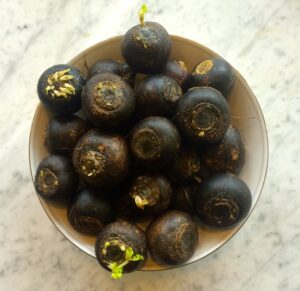 The Plum Purple radishes on my market table didn’t stay lonely and rejected for long. San Jose is home to an amazing diversity of people and the purple radishes with the big, tender, leafy greens were soon snatched up. My experiences in farmers markets taught me that Asian cultures in particular value radishes and that there are just as many varieties of radish available to plant as there are tomatoes. In an effort to widen my own farm’s appeal to a broader public I began to plant more radishes and read up about them in cookbooks. And the more I read about radishes the more surprised I was. It turns out that the long rooted form of what we today call the “Black Spanish” radish is one of the earliest kinds of vegetables that farmers ever developed, and it may be the most ancient vegetable crop that is still cultivated in its original, antique form. Before the black radish was “Spanish,” it was Egyptian, and laborers who built the pyramids ate them daily.
The Plum Purple radishes on my market table didn’t stay lonely and rejected for long. San Jose is home to an amazing diversity of people and the purple radishes with the big, tender, leafy greens were soon snatched up. My experiences in farmers markets taught me that Asian cultures in particular value radishes and that there are just as many varieties of radish available to plant as there are tomatoes. In an effort to widen my own farm’s appeal to a broader public I began to plant more radishes and read up about them in cookbooks. And the more I read about radishes the more surprised I was. It turns out that the long rooted form of what we today call the “Black Spanish” radish is one of the earliest kinds of vegetables that farmers ever developed, and it may be the most ancient vegetable crop that is still cultivated in its original, antique form. Before the black radish was “Spanish,” it was Egyptian, and laborers who built the pyramids ate them daily.
I learned that there are radishes cultivated for their seeds which are pressed into cooking oils. There are radishes that are grown for their edible, crunchy green seed pods, which are cooked as vegetables. There are radishes grown specifically for their leafy greens that are harvested and bunched, like mustard greens, and there are radish varieties that have been developed to be used as cover crops, never eaten, but designed to be tilled under to revitalize the soil. And then there are the radishes that are grown for their edible roots. If you’re a home gardener and you want to try some of these more exotic radishes you should check out the Kitazawa Seed Company in Oakland, California. (seeds@kitazawaseed.com) Their most recent catalogue that I’m flipping though now lists 45 different radish varieties! I guess that’s not too surprising. The Kitazawas are Japanese Americans, and the Japanese in particular have a deep appreciation for radishes.
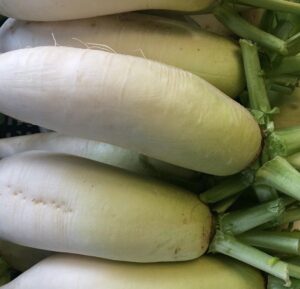 I’m smiling now, because I’m remembering a lovely fall morning several years ago when my friend, Toku, came to visit me at the greenhouses that I rent from the Nagamine family. Toku brought a friend with her who was visiting from Japan to visit my farm and the two women were chatting in Japanese when my landlord, Senior Nagamine, came out of a greenhouse where he was growing a crop of daikon radish. Mr Nagamine is in his mid 90s, but farming has kept him young at heart. Hearing the two women speaking Japanese put a smile on his face and he greeted them warmly. After some initial salutations and introductions he invited us all to inspect his daikon crop. Toku and her friend were charmed and delighted- two farm visits would be twice as fun!
I’m smiling now, because I’m remembering a lovely fall morning several years ago when my friend, Toku, came to visit me at the greenhouses that I rent from the Nagamine family. Toku brought a friend with her who was visiting from Japan to visit my farm and the two women were chatting in Japanese when my landlord, Senior Nagamine, came out of a greenhouse where he was growing a crop of daikon radish. Mr Nagamine is in his mid 90s, but farming has kept him young at heart. Hearing the two women speaking Japanese put a smile on his face and he greeted them warmly. After some initial salutations and introductions he invited us all to inspect his daikon crop. Toku and her friend were charmed and delighted- two farm visits would be twice as fun!
Did Toku like daikon, Mr. Nagamine asked? Of course Toku likes daikon. So Mr. Nagamine stooped over to pull out a fat, long, white daikon root from the ground. The radish was a good twenty inches long. Senior inspected it carefully. Unfortunately, near the tip of the root he discerned a bit of root maggot damage- just a tiny bit, to be sure- but Mr. Nagamine prefers that the produce he sells, and especially the produce he gives to guests be flawless. These days Mr. Nagamine focuses his growing operation on the production of organically cultivated traditional Japanese vegetables, specializing in the varieties he grew up with as a child in his home village of Kagoshima, Japan, but for many years of his life he grew cut flowers. If the customer expects the rose or carnation or the chrysanthemum to be perfect, why should they settle for anything less with the radish?
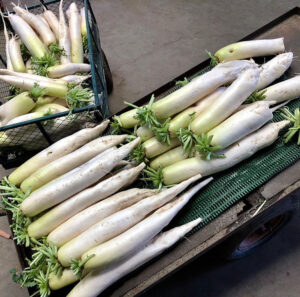 So he pulled another giant radish from the ground. This one too displayed a tiny imperfection. He was about to pull a third up when Toku stopped him. These radishes would do just fine, she said, and the imperfections were only a reminder of how the crop was grown naturally with no pesticides. Mr. Nagamine stopped pulling up radishes, and he was happy that his two visitors were happy, but he did apologize because this daikon crop was actually a Korean variety, and not the Japanese kind his guests deserved and that he usually planted. We all had a laugh at that, but it reminded me how the Koreans too are a culture that takes their radishes very seriously.
So he pulled another giant radish from the ground. This one too displayed a tiny imperfection. He was about to pull a third up when Toku stopped him. These radishes would do just fine, she said, and the imperfections were only a reminder of how the crop was grown naturally with no pesticides. Mr. Nagamine stopped pulling up radishes, and he was happy that his two visitors were happy, but he did apologize because this daikon crop was actually a Korean variety, and not the Japanese kind his guests deserved and that he usually planted. We all had a laugh at that, but it reminded me how the Koreans too are a culture that takes their radishes very seriously.
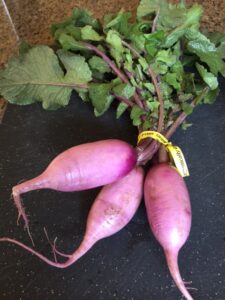 This week in your harvest box we’re including some Korean purple daikon. These radishes are very beautiful and mild flavored. They can be used in salads, and I like to slice them into thin coins and dress them with just a squeeze of lime juice. But they’re versatile. These daikon could be used in soups, cut and cubed and roasted, stir fried, pickled, shredded for slaw, and even juiced. I’ve even seen artists carve them into beautiful shapes, transforming these simple smooth roots into flowers, koi fish, and purple swans. They will also keep for a long time in the refrigerator if you don’t need a salad, a soup, a pickle, a stir fry, or a purple swan. Over the course of the cooler months we’ll see a variety of different radishes as each variety comes into its best season. By April 15th the radish concert will have been played through and we’ll begin planting our tomatoes. When we know all the vegetables the world has to offer we can have a fun food fetish for every season!
This week in your harvest box we’re including some Korean purple daikon. These radishes are very beautiful and mild flavored. They can be used in salads, and I like to slice them into thin coins and dress them with just a squeeze of lime juice. But they’re versatile. These daikon could be used in soups, cut and cubed and roasted, stir fried, pickled, shredded for slaw, and even juiced. I’ve even seen artists carve them into beautiful shapes, transforming these simple smooth roots into flowers, koi fish, and purple swans. They will also keep for a long time in the refrigerator if you don’t need a salad, a soup, a pickle, a stir fry, or a purple swan. Over the course of the cooler months we’ll see a variety of different radishes as each variety comes into its best season. By April 15th the radish concert will have been played through and we’ll begin planting our tomatoes. When we know all the vegetables the world has to offer we can have a fun food fetish for every season!
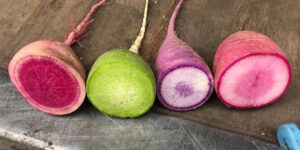
© 2020 Essay and Photos by Andy Griffin.


